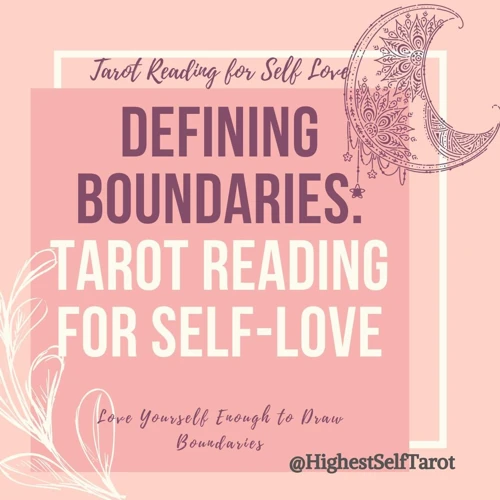Setting healthy boundaries with family members can be a challenging but necessary task for maintaining overall well-being and harmony in relationships. Whether it’s dealing with overbearing parents, intrusive siblings, or demanding relatives, establishing clear boundaries is crucial for protecting your emotional and mental health. In this article, we will explore various strategies for setting healthy boundaries with family members using the powerful tool of tarot. Through self-reflection, effective communication, and maintaining self-care practices, you can navigate family dynamics with confidence and create a balance that respects both your needs and those of your loved ones. So, grab your tarot deck and get ready to embark on a journey of self-discovery and empowerment as we delve into the world of tarot strategies for setting healthy boundaries with family members.
Contents
- Understanding Boundaries
- Identifying Boundary Issues
- Using Tarot for Boundary Setting
- Developing Effective Strategies
- Maintaining Healthy Boundaries
- Conclusion
-
Frequently Asked Questions
- 1. What are some common signs that indicate a need for setting boundaries with family members?
- 2. Can tarot really help in setting boundaries with family members?
- 3. How can self-reflection tarot spreads aid in boundary setting?
- 4. Are there specific tarot cards that symbolize boundaries?
- 5. How can effective communication techniques contribute to setting boundaries with family members?
- 6. What role does negotiation and compromise play in boundary setting?
- 7. How can self-care practices support boundary setting in family relationships?
- 8. Why is regular self-assessment important in maintaining healthy boundaries?
- 9. How can creating support systems contribute to boundary setting with family members?
- 10. Can tarot be used as an ongoing guidance tool for maintaining healthy boundaries?
- References
Understanding Boundaries

Understanding boundaries is a crucial foundation for establishing and maintaining healthy relationships with family members. Boundaries can be defined as the limits and guidelines we set for ourselves in terms of our emotional, physical, and mental well-being. It is important to recognize that boundaries are unique to each individual and may differ from person to person. Some individuals may have a high tolerance for certain behaviors, while others may have lower thresholds. To better understand boundaries, it is essential to reflect on what they mean to us personally and how they align with our values and limits. Reflecting on family dynamics can also provide insight into the patterns and dynamics that may lead to boundary issues. Recognizing our personal triggers and understanding how they relate to boundary violations can empower us to establish clear and firm boundaries that promote healthy and respectful interactions with our family members.
1.1 What are boundaries?
Boundaries are the limits and guidelines we establish for ourselves in various aspects of our lives, including our relationships with family members. They define what is acceptable and what is not in terms of our emotional, physical, and mental well-being. When it comes to family dynamics, boundaries play a crucial role in maintaining healthy and respectful interactions. They act as a protective shield that allows us to prioritize our needs, set limits on the behaviors we find unacceptable, and establish a sense of personal autonomy and individual identity within the family unit. Boundaries can encompass a wide range of areas, such as personal space, communication, emotional openness, and decision-making. They are not meant to isolate or separate us from our family. Instead, boundaries provide a framework for healthy and balanced relationships, promoting mutual respect, understanding, and maintaining the overall well-being of everyone involved. By understanding and defining our boundaries, we empower ourselves to engage in relationships with our family members that are based on respect, compassion, and a mutual sense of growth and support.
To learn more about healing family wounds through tarot, you can check out our article: Healing Family Wounds with Tarot.
1.2 Importance of setting boundaries
Setting boundaries with family members is of utmost importance for several reasons. Firstly, establishing boundaries allows us to define and protect our personal space, both physically and emotionally. By having clear boundaries, we can create a sense of safety and security within our relationships. This safeguarding of personal space is crucial for maintaining healthy boundaries and preventing any form of emotional, physical, or mental harm. Additionally, setting boundaries promotes respect and mutual understanding. It helps family members understand our needs, limitations, and preferences, fostering healthier and more balanced relationships. When boundaries are established, it becomes easier to navigate interactions without crossing each other’s boundaries, reducing conflicts and misunderstandings. By communicating and enforcing our boundaries, we also enhance our self-esteem and self-worth, as we assert our right to be treated with respect and dignity. Ultimately, setting boundaries is an act of self-care and self-preservation, allowing us to nurture our well-being while cultivating healthier dynamics within our family relationships. For additional insights on understanding family dynamics, tarot can be a valuable tool, providing guidance and clarity in exploring ancestral connections and the roles we play within our families. To explore these topics further, consider checking out these insightful articles on exploring ancestral connections through lineage tarot readings and understanding family roles and dynamics through tarot.
Identifying Boundary Issues

Identifying boundary issues within our family dynamics is an important step in setting and maintaining healthy boundaries. One way to begin this process is by reflecting on the dynamics within our family and the roles that each member plays. By examining these roles, we can gain a deeper understanding of how they may contribute to boundary violations. Additionally, it is important to recognize and acknowledge our own personal triggers – the specific behaviors or situations that push our boundaries. This self-awareness allows us to identify patterns and situations where we may feel uncomfortable or disrespected. By pinpointing these triggers, we can better address them and establish boundaries that protect our emotional well-being. Whether it is with a controlling parent or an overly dependent sibling, recognizing and understanding boundary issues within our family dynamics is an essential step towards fostering healthier and more respectful relationships.
2.1 Reflecting on family dynamics
Reflecting on family dynamics is an essential step in understanding boundary issues and finding effective ways to address them. Each family has its unique dynamics shaped by various factors such as cultural background, upbringing, and individual personalities. Take the time to observe and analyze how your family interacts with one another. Pay attention to recurring patterns, power dynamics, and communication styles within the family. Reflect on the roles that each family member plays and how these roles may contribute to boundary issues. For example, some family members might have a tendency to be overly controlling or dismissive of others’ boundaries. Others may struggle with setting their own boundaries due to a fear of conflict or a desire to please everyone. By gaining a deeper understanding of these dynamics, you can identify specific situations or behaviors that trigger boundary violations. With this awareness, you can begin to develop strategies tailored to your family’s unique dynamics and challenges. Remember, self-reflection is key in uncovering the root causes of boundary issues and finding ways to create healthier dynamics within your family.
2.2 Recognizing personal triggers
Recognizing personal triggers is an essential step in setting healthy boundaries with family members. Triggers are specific thoughts, feelings, or actions that cause intense emotional reactions or discomfort. These triggers often stem from past experiences, traumas, or unresolved conflicts within family dynamics. By identifying our personal triggers, we can better understand why certain behaviors or situations cause us distress or anxiety. It is important to acknowledge that triggers can be unique to each individual, as what may trigger one person may not affect another in the same way. Some common triggers in familial relationships may include criticism, invasive questions, disregard for personal boundaries, or judgmental comments. Once we are aware of our triggers, we can begin to develop coping mechanisms to manage our emotional responses and establish boundaries accordingly. Recognizing personal triggers empowers us to communicate with our family members in a constructive and assertive manner, expressing our needs and preferences while fostering healthy relationships.
Using Tarot for Boundary Setting

Using tarot as a tool for boundary setting can provide valuable insight and guidance in navigating complex family dynamics. Tarot cards have a unique ability to tap into our subconscious, allowing us to gain a deeper understanding of ourselves and our relationships. Self-reflection tarot spreads can help us explore our emotions, thoughts, and boundaries more clearly. By examining various aspects of our lives, such as past experiences, current challenges, and future aspirations, tarot can offer a fresh perspective on setting boundaries with family members. Additionally, tarot can serve as a guidance tool, providing us with valuable advice and wisdom on how to effectively communicate our boundaries, negotiate with our loved ones, and find a healthy balance between our needs and the needs of our family. Whether through daily tarot pulls, specific spreads, or seeking professional tarot readers, incorporating tarot into our boundary-setting journey can foster self-awareness, empowerment, and ultimately lead to more fulfilling and harmonious relationships with our family members.
3.1 Self-reflection tarot spreads
Self-reflection tarot spreads can be valuable tools for exploring and gaining insight into our own feelings, boundaries, and desires when it comes to dealing with family dynamics. These spreads are designed to prompt deep self-reflection and provide guidance on how to establish and maintain healthy boundaries with family members.
One popular self-reflection tarot spread is the “Boundaries Check-In” spread. This spread consists of pulling cards that represent different aspects of boundaries, such as emotional boundaries, physical boundaries, and communication boundaries. These cards can provide insight into areas where boundaries may need strengthening or where limits may need to be set.
Another helpful self-reflection tarot spread is the “Family Issues” spread. This spread focuses specifically on family dynamics and allows us to explore our feelings and thoughts about various family members and situations. The cards can uncover underlying emotions, triggers, and potential strategies for setting boundaries effectively.
Tarot spreads like these can aid in self-awareness, personal growth, and decision-making. By reflecting on the messages conveyed by the cards, we can gain a deeper understanding of our own needs and boundaries, enabling us to navigate family relationships with greater clarity and confidence. Whether you choose to use pre-existing tarot spreads or create your own, self-reflection tarot spreads are a powerful tool for exploring and setting healthy boundaries with family members.
3.2 Tarot as a guidance tool
Tarot can serve as a powerful guidance tool when it comes to setting boundaries with family members. The cards can provide insights, clarity, and guidance as we navigate complex familial relationships. When using tarot as a guidance tool for boundary setting, it is important to approach the readings with an open mind and a willingness to explore different perspectives. The tarot cards act as a mirror, reflecting our subconscious thoughts, emotions, and desires. They can help us uncover any hidden fears, insecurities, or patterns that may be affecting our ability to set and maintain boundaries. Each card carries its own unique symbolism and meaning, which can be interpreted in relation to our specific boundary issues. For example, drawing cards like the Queen of Swords or the Tower may indicate the need for assertiveness or the breaking down of unhealthy dynamics. On the other hand, cards like the Temperance or the Four of Cups may suggest the importance of finding balance and emotional harmony within ourselves before addressing boundary concerns. Tarot readings can also provide practical advice and action steps to help us navigate difficult situations and establish boundaries with compassion and clarity. By using tarot as a guidance tool, we can tap into our intuition, gain deeper self-awareness, and make informed decisions that align with our personal boundaries and values. So, the next time you find yourself seeking guidance in setting boundaries with family members, consider turning to tarot for valuable insights and support.
Developing Effective Strategies

Developing effective strategies is essential for setting and maintaining healthy boundaries with family members. Communication techniques play a vital role in establishing clear and open lines of communication. This includes expressing your needs, concerns, and boundaries assertively and respectfully. Active listening and empathetic understanding are crucial skills to ensure that both parties feel heard and understood. Negotiation and compromise are also essential aspects of boundary setting, allowing for a mutually beneficial outcome. It is important to find a balance between asserting your own needs while also considering the needs and feelings of your family members. Additionally, self-care practices are vital in maintaining healthy boundaries. Taking care of your physical, emotional, and mental well-being allows you to establish and maintain boundaries effectively. This may include practicing self-reflection, engaging in activities that bring you joy and relaxation, and seeking support from trusted friends or professionals when needed. By combining effective communication techniques, negotiation and compromise, and a commitment to self-care, you can develop strategies that support healthy boundary setting within your family dynamics.
4.1 Communication techniques
Communication techniques play a vital role in setting and maintaining healthy boundaries with family members. When it comes to addressing boundary issues, effective communication is key. Here are some techniques that can help improve communication in boundary-setting situations:
- Active Listening: Active listening involves fully focusing on and understanding what the other person is saying. It requires giving them your undivided attention, acknowledging their perspective, and responding appropriately. By actively listening, you create a safe space for open dialogue and mutual understanding.
- Assertive Communication: Assertive communication is about expressing your needs, desires, and boundaries in a clear and respectful manner. It involves using “I” statements to express how you feel, setting specific boundaries, and standing firm in your convictions without being aggressive or passive.
- Setting Clear Expectations: Clearly express your expectations and boundaries to your family members. Be specific about what behaviors are acceptable and unacceptable to you. By setting clear expectations, you can avoid misunderstandings and promote healthier interactions.
- Non-Verbal Communication: Remember that communication is not just about words; non-verbal cues also play a significant role. Use non-verbal communication effectively by maintaining eye contact, using open body language, and paying attention to your tone of voice. Consistency between verbal and non-verbal cues helps convey your message more effectively.
- Boundary Reinforcement: After expressing your boundaries, reinforce them by consistently following through with actions. This shows that your boundaries are important to you and helps others understand the consequences of crossing them.
By utilizing these communication techniques, you can foster healthier and more respectful conversations with your family members, ensuring that your boundaries are understood and respected. Effective communication is a vital component of maintaining harmonious relationships while preserving your own well-being.
4.2 Negotiation and compromise
Negotiation and compromise play a crucial role in setting and maintaining healthy boundaries with family members. When faced with boundary issues, it is important to approach the situation with an open mind and a willingness to find common ground. Negotiation involves engaging in a constructive dialogue with your family member to express your needs and concerns while also considering their perspective. This process requires active listening, empathy, and a willingness to find mutually beneficial solutions. Compromise, on the other hand, involves finding a middle ground where both parties can feel acknowledged and respected. It may require making concessions or adjustments to your boundaries to reach a resolution that satisfies everyone involved. While compromise is essential, it is important to remember that compromising should never compromise your own well-being or violate your core values. The key is to strike a balance between asserting your personal boundaries and finding common ground that promotes healthy and harmonious relationships with your family members.
4.3 Self-care practices
Self-care practices play a vital role in maintaining healthy boundaries with family members. It is important to prioritize self-care to ensure your own well-being while navigating complex family dynamics. Here are some effective self-care practices that can support you in setting and maintaining boundaries:
1. **Self-reflection and self-awareness:** Take time for self-reflection to identify your needs, emotions, and triggers. This awareness allows you to recognize when your boundaries are being crossed and helps you respond assertively.
2. **Establishing personal boundaries:** Clearly define your personal boundaries and communicate them with your family members. This might involve expressing your limits, stating what is acceptable or unacceptable, and asserting yourself when necessary.
3. **Saying “no” when needed:** Practice saying “no” confidently and without guilt when a request or demand from a family member exceeds your capabilities or violates your boundaries. Remember, it is okay to prioritize your own needs and well-being.
4. **Creating a self-care routine:** Develop a routine that includes activities that bring you joy, relaxation, and peace. This may involve engaging in hobbies, practicing mindfulness or meditation, exercising, or spending quality time alone. These self-care activities can help replenish your energy and provide a sense of balance.
5. **Seeking support:** Reach out to friends, therapists, or support groups who can provide guidance, validation, and understanding. Sometimes, discussing your experiences with others who have similar experiences can provide clarity and additional tools for boundary setting.
6. **Setting boundaries with technology:** Establish boundaries around technology use, such as designating screen-free time or limiting communication with family members who consistently disregard your boundaries. Unplugging from technology can facilitate self-care and create space for personal growth and introspection.
Remember, self-care practices are unique to each individual, so explore and experiment with different techniques to find what works best for you. Prioritizing self-care and honoring your boundaries will contribute to healthier and more fulfilling relationships with your family members.
Maintaining Healthy Boundaries
Maintaining healthy boundaries is an ongoing process that requires regular self-assessment and the implementation of effective strategies. Regularly assessing our boundaries allows us to gauge if they are still aligned with our needs and if any adjustments need to be made. Creating support systems, such as seeking therapy or joining support groups, can provide guidance and validation when faced with challenging situations. It is important to prioritize self-care and engage in activities that promote our well-being, as this helps us stay grounded and assertive in upholding our boundaries. In this journey, tarot can serve as a valuable tool for ongoing guidance and insight, providing clarity and direction when faced with boundary-related decisions. By integrating these practices into our lives, we can cultivate and maintain healthy boundaries with family members, fostering harmonious and balanced relationships.
5.1 Regular self-assessment
Regular self-assessment is a key component in maintaining healthy boundaries with family members. It involves taking the time to reflect on our emotions, thoughts, and overall well-being in relation to our interactions with family. By engaging in regular self-assessment, we can gain a deeper understanding of our needs, limits, and any changes in our boundary preferences. It’s important to ask ourselves questions such as: Am I feeling overwhelmed or stressed after spending time with certain family members? Are there any recurring patterns or behaviors that consistently push my boundaries? Is there a balance between giving and receiving in my relationships with family members? Self-assessment allows us to honestly evaluate our experiences and examine how our boundaries are being respected or violated. It also helps us identify any areas where our boundaries may need adjustment or reinforcement. Through self-reflection and introspection, we can ensure that our boundaries remain aligned with our values and prioritize our well-being. Regular self-assessment empowers us to make informed decisions about how we engage with our family members and take necessary actions to enforce and communicate our boundaries effectively. By regularly checking in with ourselves, we can maintain a healthy and balanced dynamic within our family relationships.
5.2 Creating support systems
Creating support systems is an essential component of maintaining healthy boundaries with family members. When faced with challenging situations or difficult interactions, having a strong support network can provide the encouragement and guidance needed to stay firm in establishing and enforcing boundaries. One way to create a support system is by seeking out trusted friends or mentors who can offer a listening ear, objective advice, and emotional support. These individuals can provide an outside perspective and help validate your feelings and decisions. Additionally, joining support groups or online communities with individuals who have experienced similar boundary issues can be incredibly valuable. These groups offer a safe space to share experiences, gain insights, and learn from others’ strategies and coping mechanisms. It is important to surround yourself with people who understand and respect the importance of boundaries and can provide encouragement and reassurance when faced with resistance or guilt from family members. Remember, creating a strong support system empowers you to stay committed to your boundaries and reinforces your sense of self-worth and autonomy.
5.3 Tarot for ongoing guidance
Tarot can be a powerful tool for ongoing guidance in maintaining healthy boundaries with family members. By consistently incorporating tarot into your self-care routine, you can seek answers and insights that can help you navigate complex family dynamics. One way to use tarot for ongoing guidance is by performing regular tarot readings focused on your boundary-setting journey. You can create a specific tarot spread that addresses your current challenges, goals, and progress in maintaining healthy boundaries with family members. The cards can provide valuable insights, guidance, and confirmation of your intuition. Additionally, you can use tarot as a tool for reflection and self-assessment. By conducting periodic readings, you can check in with yourself and evaluate how well you are maintaining your boundaries and if any adjustments or modifications are necessary. Tarot can also assist in finding solutions to any challenges or conflicts that may arise within family relationships. The archetypal imagery and symbolism in tarot cards offer a unique perspective and can shed light on possible resolutions or approaches to specific situations. Remember to approach tarot readings with an open mind and allow the cards to guide you towards deeper self-awareness and the manifestation of healthy boundaries with your family members. With tarot as an ongoing source of guidance, you can continue to grow and evolve in your boundary-setting journey, fostering more fulfilling and harmonious relationships within your family.
Conclusion
In conclusion, setting healthy boundaries with family members is a lifelong journey that requires self-reflection, effective communication, and ongoing self-care. By utilizing tarot as a tool for guidance and self-assessment, individuals can gain valuable insights into their own needs, triggers, and boundaries. Through tarot, one can develop a deeper understanding of family dynamics and identify areas where boundaries may need to be established or strengthened. Communication techniques, such as assertiveness and active listening, play a vital role in effectively expressing and upholding boundaries with family members. Negotiation and compromise can also be beneficial in finding common ground and maintaining harmony within relationships. Additionally, implementing regular self-assessment and self-care practices allows individuals to prioritize their well-being and make necessary adjustments to their boundaries as needed. It is important to remember that setting boundaries is not about cutting off or distancing oneself from family, but rather about creating a healthy and balanced dynamic that respects and honors the needs and boundaries of all family members involved. By using tarot as a continued source of guidance and support, individuals can navigate the complexities of family relationships with confidence and clarity. So, embrace the wisdom of tarot, trust your intuition, and embark on a journey of growth and empowerment in establishing and maintaining healthy boundaries with your family members.
Frequently Asked Questions
1. What are some common signs that indicate a need for setting boundaries with family members?
Common signs may include feeling overwhelmed, constantly being criticized or judged, experiencing a lack of respect for personal space, feeling guilt-tripped or manipulated, and having your needs consistently overlooked or invalidated.
2. Can tarot really help in setting boundaries with family members?
Absolutely! Tarot can serve as a powerful tool for self-reflection and guidance. It can help you gain clarity on your values, emotions, and boundaries, enabling you to communicate them effectively and make informed decisions regarding family dynamics.
3. How can self-reflection tarot spreads aid in boundary setting?
Self-reflection tarot spreads provide a structured way to explore your thoughts, emotions, and experiences related to family boundaries. They can help you gain deeper insights, uncover patterns, and identify areas where boundaries may need to be strengthened.
4. Are there specific tarot cards that symbolize boundaries?
While tarot cards do not represent boundaries explicitly, certain cards can offer guidance and insights related to setting and maintaining boundaries. Cards like the High Priestess, the Emperor, and the Eight of Swords can often reflect themes of personal power, authority, and the need for assertiveness.
5. How can effective communication techniques contribute to setting boundaries with family members?
Effective communication is key to setting boundaries. It involves expressing your needs, feelings, and expectations in a clear and assertive manner while actively listening to others. By communicating openly and honestly, you can foster understanding and create healthier dynamics within your family relationships.
6. What role does negotiation and compromise play in boundary setting?
Negotiation and compromise are essential when it comes to maintaining healthy boundaries in family relationships. It involves finding a balance between your own needs and those of your family members, seeking mutually agreeable solutions, and being open to finding middle ground that respects everyone’s boundaries.
7. How can self-care practices support boundary setting in family relationships?
Self-care practices play a vital role in maintaining healthy boundaries. By prioritizing self-care, you nurture your emotional, mental, and physical well-being, which allows you to set clear boundaries and protect your personal boundaries when interacting with family members.
8. Why is regular self-assessment important in maintaining healthy boundaries?
Regular self-assessment helps you stay attuned to your own needs and boundaries. It allows you to reflect on whether your boundaries are being respected, identify any changes or adjustments that may be necessary, and take proactive steps to reinforce and maintain healthy boundaries.
9. How can creating support systems contribute to boundary setting with family members?
Creating support systems involves seeking out trusted friends, therapists, or support groups who can provide validation, guidance, and encouragement as you navigate the challenges of boundary setting with family members. They can offer a safe space to share experiences and gain valuable insights.
10. Can tarot be used as an ongoing guidance tool for maintaining healthy boundaries?
Yes, tarot can serve as an ongoing guidance tool. Regular tarot readings can help you gain fresh perspectives, identify potential areas of boundary challenges, and provide guidance on how to navigate those situations with clarity and confidence.






